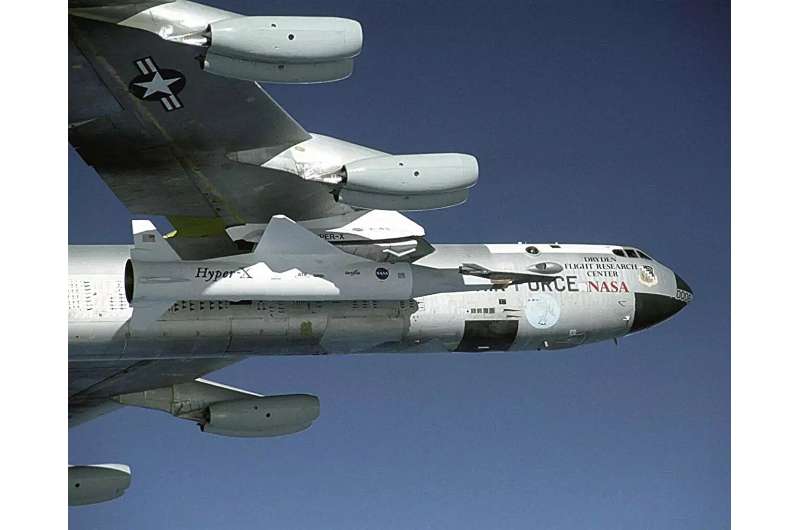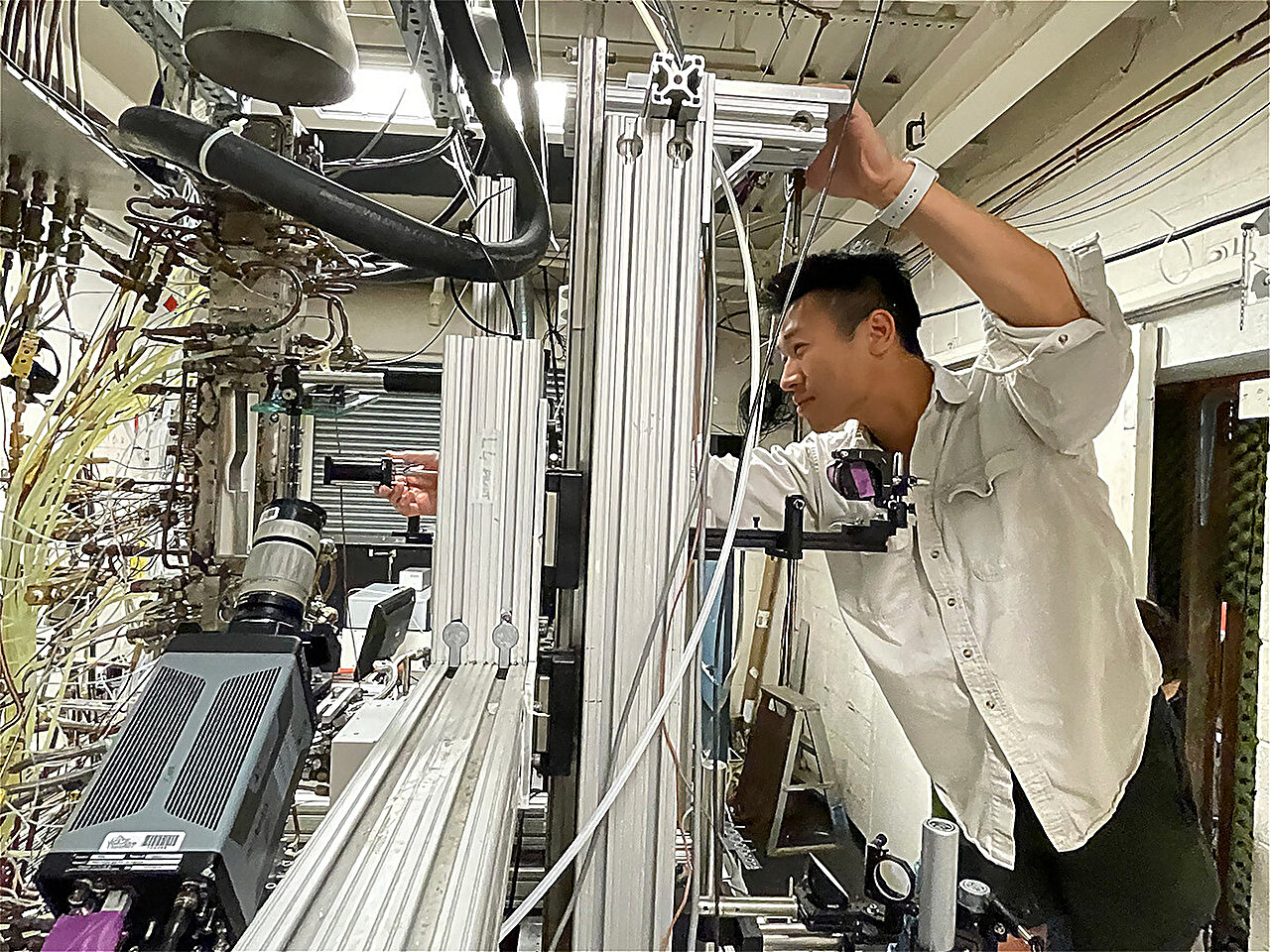Doctoral student Max Chern takes a closer look at the wind tunnel setup where researchers from the University of Virginia School of Engineering and Applied Science have demonstrated that control of a dual-mode scramjet engine is possible with an optical sensor. Credit: Wende Whitman, UVA Engineering
What if the future of space travel looked less like Space-X’s rocket-powered spaceship and more like NASA’s “Hyper-X,” the hypersonic jet plane that flew faster than any aircraft before or since 20 years ago this year?
In 2004, NASA’s final X-43A unmanned prototype tests marked a milestone in the latest era of jet development: the leap from ramjets to faster, more efficient scramjets. The final test, in November of that year, recorded a world-record speed that only a rocket had previously achieved: Mach 10. The speed is equal to 10 times the speed of sound.
NASA gathered a lot of useful data from the tests, and six years later the Air Force did the same in similar tests with the X-51 Waverider before the prototypes ended up in the ocean.
Although the hypersonic proof of concept was successful, the technology was far from operational. The challenge was achieving engine control, as the technology was based on decades-old sensor approaches.
However, this month brought some hope for potential successors to the X-plane series.
As part of a new study, researchers from the University of Virginia School of Engineering and Applied Science published data in the June issue of the journal Aerospace science and technology which show for the first time that the airflow in supersonic combustion jet engines can be controlled by an optical sensor. The finding could lead to more efficient stabilization of hypersonic jets.
Additionally, the researchers achieved adaptive control of a scramjet engine, which is a first for hypersonic propulsion. Adaptive engine control systems respond to changes in dynamics to maintain optimal overall system performance.
“One of our national priorities in aerospace since the 1960s has been to build single-stage-to-orbit aircraft that fly from a horizontal takeoff into space like a traditional airplane and land on the ground like a traditional airplane,” said Professor Christopher Goyne, director of the UVA Aerospace Research Laboratory, where the research took place.
“Currently, the most advanced craft is the SpaceX Starship. It has two stages, with vertical launch and landing. But to optimize safety, convenience and reusability, the aerospace community wants to build something more like a 737. “
Goyne and his co-researcher, Chloe Dedic, an associate professor of engineering at UVA, believe that optical sensors could play an important role in control engineering.
“It seemed logical to us that if an aircraft is flying at hypersonic speeds of Mach 5 and above, it would be better to embed sensors that are closer to the speed of light than the speed of sound,” Goyne said.
Other members of the team included doctoral student Max Chern, who served as first author of the paper, and former doctoral student Andrew Wanchek, doctoral student Laurie Elkowitz and UVA senior scientist Robert Rockwell. The work was supported by a NASA ULI grant led by Purdue University and principal investigator T. Pourpoint.
Stop ‘unstarting’ to maintain control
NASA has long tried to prevent something that can occur in scramjet engines called “unstart.” The term indicates a sudden change in airflow. The name is derived from a specialized test facility called a supersonic wind tunnel, where a “start” means the wind has reached the desired supersonic conditions.
UVA has several supersonic wind tunnels, including the UVA Supersonic Combustion Facility, which can simulate engine conditions for a hypersonic vehicle traveling five times the speed of sound.
“We can run test conditions for hours, allowing us to experiment with new flow sensors and control approaches on realistic engine geometry,” Dedic said.
Goyne explained that “scramjets,” short for supersonic burner ramjets, build on ramjet technology that has been in common use for years.
Ramjets essentially “ram” air into the engine using the aircraft’s forward motion to generate the temperatures and pressures needed to burn fuel. They operate in a range of approximately Mach 3 to Mach 6. As the intake at the front of the craft narrows, the internal airspeed slows to subsonic speeds in a ramjet internal combustion engine. However, the plane itself does not do that.
Scramjets are a little different though. While they are also “air breathing” and have the same basic layout, they need to maintain that super fast airflow through the engine to reach hypersonic speeds.
“If something happens in the hypersonic engine, and you suddenly get subsonic conditions, that’s a no-start,” Goyne said. “The thrust will suddenly drop off, and it can be difficult to restart the intake at that point.”

NASA’s B-52B launch plane sails to a test range over the Pacific Ocean carrying the third and final X-43A vehicle, attached to a Pegasus rocket, on November 16, 2004. Credit: NASA
Testing a dual-mode scramjet engine
Currently, scramjet engines, like ramjets, require a boost to get them up to a speed where they can take in enough oxygen to operate. This can be a ride attached to the bottom of an airplane or a rocket boost.
The latest innovation is a dual-mode scramjet combustion plant, the type of engine tested by the UVA project. The twin engine starts in ramjet mode at lower Mach numbers and then switches to receiving a full supersonic airflow into the combustion chamber at speeds above Mach 5.
It is critical to prevent the engine from misfiring while making that transition.
The incoming wind interacts with the inlet walls in the form of a series of shock waves known as a ‘shock train’. Traditionally, the leading edge of these waves, which can be destructive to the integrity of the aircraft, is monitored by pressure sensors. For example, the machine can adjust by moving the position of the shock train.
But where the leading edge of the shock train is can change rapidly as flight disturbances alter the dynamics in the air. The shock train can pressurize the intake, creating conditions for a launch.
So, “If you’re sensing at the speed of sound and the motor processes are moving faster than the speed of sound, you don’t have much response time,” Goyne said.
He and his associates wondered if they could predict that the engine would no longer start by looking at the properties of the engine’s flame.
Observing the spectrum of a flame
The team decided to use an optical emission spectroscopy sensor to provide the feedback needed to control the leading edge of the shock train.
The optical sensor is no longer limited to information obtained from the walls of the engine, as is the case with pressure sensors, but can identify subtle changes both in the engine and in the flow path. The tool analyzes the amount of light emitted by a source (in this case, the reacting gases in the scramjet burner) as well as other factors such as the location of the flame and its spectral content.
“The light emitted by the flame in the engine is due to the relaxation of molecular species excited during combustion processes,” explained Elkowitz, one of the doctoral students. “Different species emit light at different energies or colors, which provides new information about the state of the engine that is not captured by pressure sensors.”
The team’s wind tunnel demonstration showed that the engine control can be both predictive and adaptive, with a smooth transition between scramjet and ramjet operation.
The wind tunnel test was in fact the world’s first proof that adaptive control in these types of dual-function engines can be achieved with optical sensors.
“We were very excited to demonstrate the role that optical sensors can play in controlling future hypersonic vehicles,” said first author Chern. “We continue to test sensor configurations as we work toward a prototype that optimizes package volume and weight for flight environments.”
Building the future
Although much work remains to be done, Goyne thinks optical sensors could be part of the future that will be realized within his lifetime: an airplane-like journey to space and back.
Dual-mode scramjets would still need some boost to get the plane to at least Mach 4. But there would be the added safety of not relying solely on rocket technology, which requires carrying highly flammable fuel alongside large amounts of chemical oxidizer to burn the fuel.
That reduced weight would allow for more room for passengers and cargo.
Such an all-in-one aircraft, which would one day float back to Earth like the space shuttles, could even offer the ideal combination of cost-efficiency, safety and reusability.
“I think it’s possible, yes,” Goyne said. “While the commercial space industry has been able to reduce costs through some reusability, they haven’t yet mastered aircraft-like operations. Our findings could potentially build on the storied history of Hyper-X and make access to space safer than current rocket-based technology.”
More information:
Max Y. Chern et al, Control of a dual-mode scramjet current path using optical emission spectroscopy, Aerospace science and technology (2024). DOI: 10.1016/j.ast.2024.109144
This work was financially supported by NASA’s Space Technology Research Grants Program (NASA ULI Grant #80NSSC21M0069 P00001).
Offered by the University of Virginia
Quote: Wind tunnel study shows power of hypersonic jet engines can be controlled optically (2024, June 27), retrieved June 29, 2024 from https://phys.org/news/2024-06-tunnel-hysonic-jet-optical.html
This document is copyrighted. Except for fair dealing purposes for the purpose of private study or research, no part may be reproduced without written permission. The content is provided for informational purposes only.
